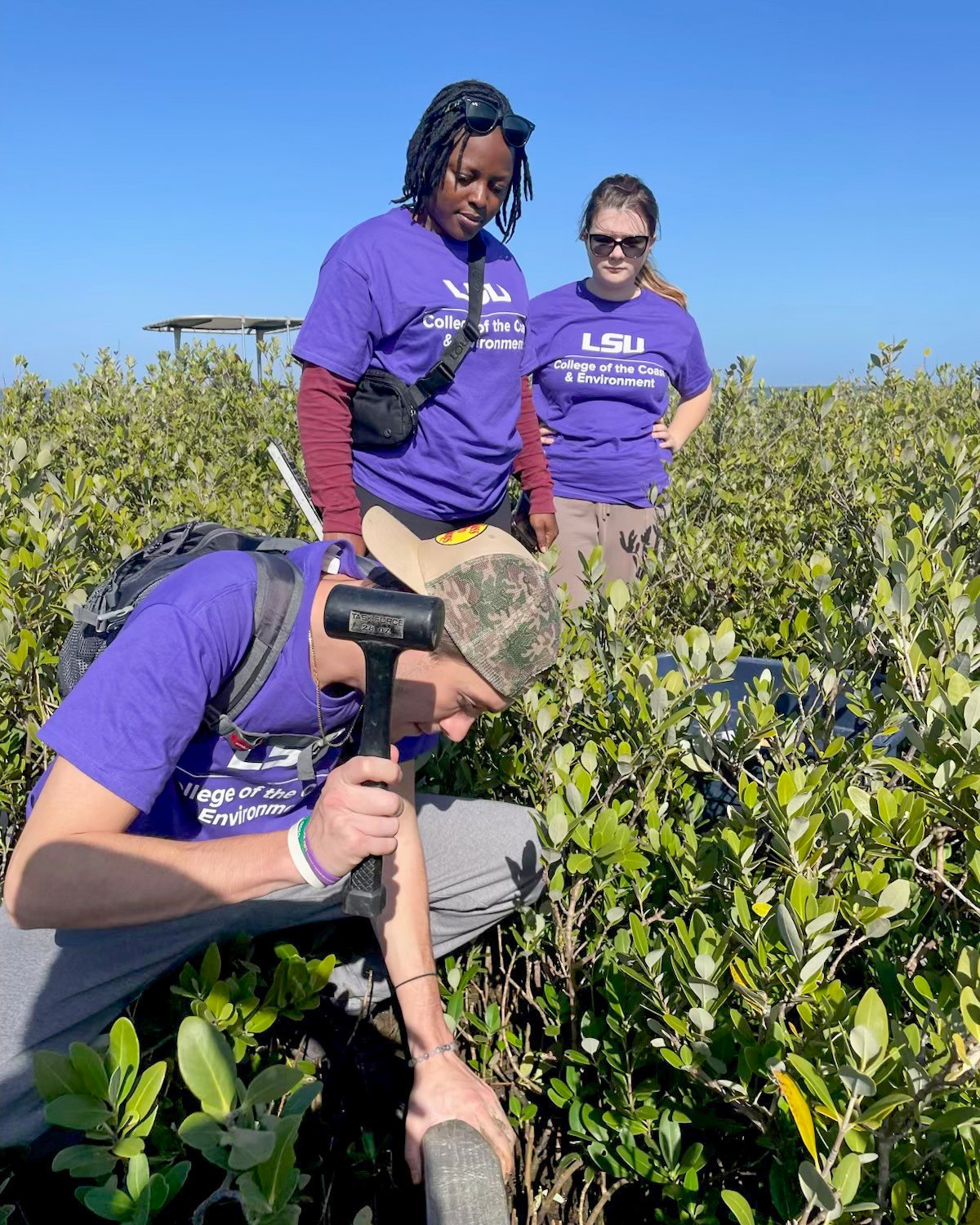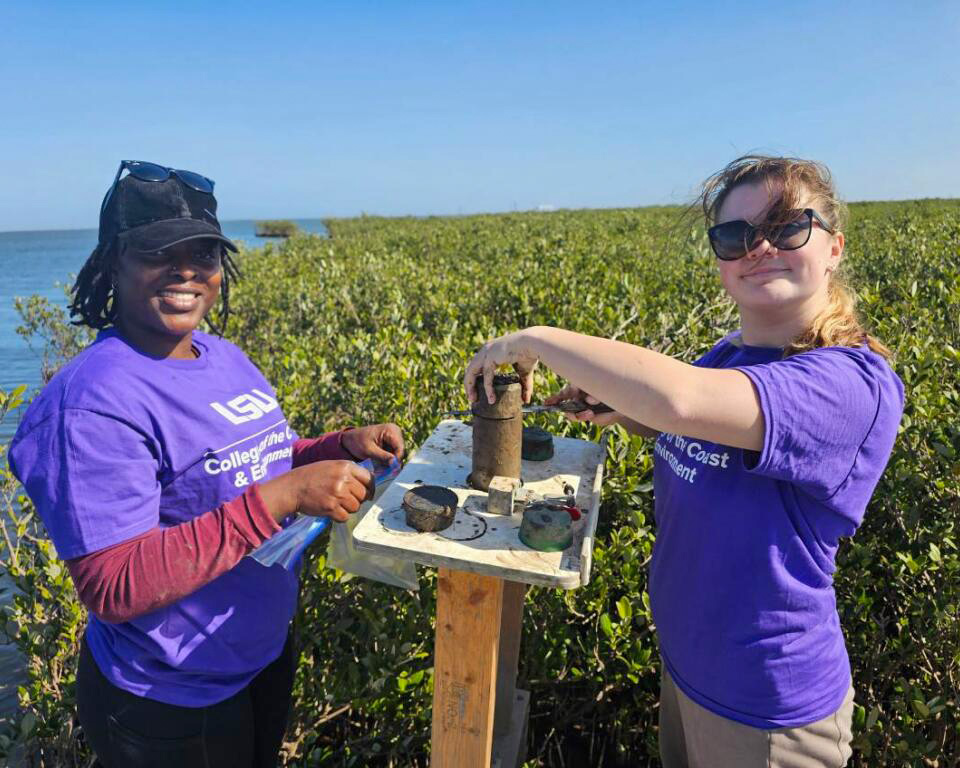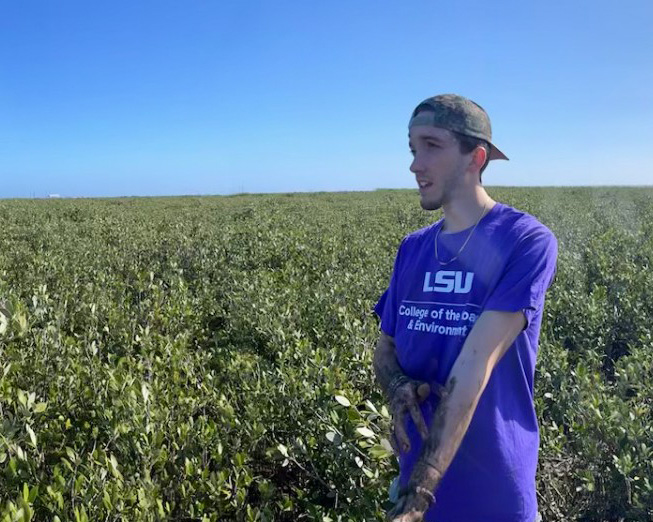The March of the Mangroves
January 31, 2025

From left: Nico Lonergan, Eloho Aghworo and Katherine Aranda
CC&E student researchers are getting their hands dirty as they learn more about Louisiana's newest coastal denizens, the black mangroves.
On a sunny day in early January, John White, a professor in the Department of Oceanography & Coastal Sciences, took three students on a sampling trip to Louisiana’s Port Fourchon area.
The group was in search of some relatively new denizens to Louisiana’s troubled coastal marshes - black mangroves. The mangroves, a slightly more cold-tolerant variety than the red mangroves found along the Florida and Texas coasts, have been making their way slowly northward, and have arrived in the Mississippi Delta, as the climate warms.
White said the plants have significant differences from the herbaceous marshes making up the majority of Louisiana’s coastal wetlands. “Mangroves are trees and therefore grow more slowly than our marsh grasses but also have more resistant carbon, which breaks down more slowly. Wood stays around a lot longer than grasses in the environment,” he said.
White also noted that that the long-term impact of the mangroves is as yet unknown. “This poleward migration of mangroves might have positive or negative effects, depending on which wetland functions we value.”
The potential swath of the black mangrove’s impact is wide, and White’s students, all members of his Wetland and Aquatic Biogeochemistry Laboratory, are examining the incomers’ effects on everything from existing marsh grass to carbon cycling and coastal restoration.
Masters student Nico Lonergan is interested in the ways black mangroves interact with thin layer dredge sediment. “The goal of my research is to compare the biogeochemical cycles of a natural mangrove ecosystem to a mangrove ecosystem that has been reconstructed or restored with dredge sediment,” Lonergan, who graduated with from Coastal Environmental Science in fall of 2024, said.
He noted that there is little literature on the topic, even though black mangroves are increasingly common and restoration efforts frequently involve dredged sediment. “It's important to understand how restoration efforts that we've used in the past on herbaceous marshes, how that's going to apply to the new ecosystem… based on a black mangrove,” he said.
“We have a lot of it in Louisiana, from digging canals and oil pipelines,” he said. “So it’s a beneficial use to of this sediment and we want to see if using it will not have any negative biogeochemical impacts.”
Eloho Aghworo’s portion of the project takes a step back to look at the impacts a black mangrove marsh may have on carbon storage, which has implications for warming temperatures around the globe. Currently, Louisiana’s herbaceous coastal wetlands function as a significant carbon sink.
Aghworo, a Masters student in Oceanography and Coastal Science, who is also completing her Phd in Environmental Sciences, is investigating how black mangroves will cycle carbon. “The encroachment of mangroves into salt marshes is a real indicator of climate change, highlighting how ecosystems are responding to rising temperatures, shifting freeze thresholds, and sea-level rise,” she said. “Studying these transitions allows us to explore how natural systems adapt, offering insights into their resilience and vulnerabilities.”
She continued, “the implications of this research are profound. Mangroves and salt marshes are not only carbon sinks but also vital buffers that protect coastal communities from storm surges and erosion.”
Katherine Aranda’s research focuses on how mangroves and herbaceous marshes cycle nitrogen and other microbial processes. Aranda, a Coastal Environmental Science major, would like to help broaden “the understanding of how introduced species such as black mangroves compare to native species, such as saltmarsh grass, in terms of microbial processes and how differences in those processes may impact ecosystem services such as water quality. improvement”
Aranda, who is also a Louisiana Service and Leadership Scholar at the Ogden Honors College, hopes her research will shed light on the impacts of a black mangrove incursion: “What are the consequences of having new, introduced species be more prevalent than the native plants, and what that can mean for environmental services and the coast itself?” she said.

Aghworo and Aranda process a sample soil.

Lonergan in the wetlands near Port Fourchon.